|
|
|
Sort Order |
|
|
|
Items / Page
|
|
|
|
|
|
|
| Srl | Item |
| 1 |
ID:
106009
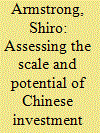

|
|
|
|
|
| Publication |
2011.
|
| Summary/Abstract |
The recent rise in Chinese outward direct investment (ODI) has significant global implications and impacts on host country policy. The present paper attempts to provide a theoretical basis and to define a robust econometric approach to assess the performance and potential of Chinese ODI. In this paper, foreign direct investment (FDI) performance is estimated using a frontier FDI model to measure how foreign investors, especially China, and the recipients of this direct investment perform relative to a benchmark of potential FDI. The results show that Chinese ODI achieves less of its potential compared with other investors. However, its ODI to Australia has performed much better than investment to other destinations. The results suggest that Chinese policy-makers should look at the pattern of China's ODI and, in light of superior performance in destinations like Australia, adjust policy strategies and institutional arrangements to enhance performance and reduce barriers to Chinese ODI.
|
|
|
|
|
|
|
|
|
|
|
|
|
|
|
|
| 2 |
ID:
106008


|
|
|
|
|
| Publication |
2011.
|
| Summary/Abstract |
Chinese outward direct investment (ODI) appears to differ from that of advanced economies. Is there a unique China model? By reviewing industry distributions of ODI data for 2003-2009, we found that Chinese ODI was not concentrated in industries that performed well either in exporting or domestically. Statistical analyses also confirmed that traditional variables, such as market size, production cost and legal environment, did not impact Chinese investors' choice of location for ODI. Instead, investors selected places where they could either learn advanced technologies or secure stable commodity supplies. We have tentatively concluded that the main purpose of the China model of ODI has not been to expand production overseas but to strengthen industries at home.
|
|
|
|
|
|
|
|
|
|
|
|
|
|
|
|
| 3 |
ID:
106014
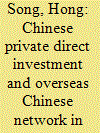

|
|
|
|
|
| Publication |
2011.
|
| Summary/Abstract |
Based on extensive interviews in China and in Africa over 2 years, the present paper investigates Chinese private direct investment in Africa. Drawing on the Swedish Uppsala model, we explore two mian issues. First, do Chinese private enterprises follow the linear mode to invest in Africa? Second, if not, how do they go out and develop their investments, and who helps them overcome the obstacles to investing in Africa? We find that very few Chinese private enterprises follow a linear internationalization process, and most depend on the local overseas Chinese network and other networks to facilitate their entry into the host market. The reason lies in that Chinese private enterprises are still at the early stage of internationalization. Entrepreneurship is one of the most important ownership advantages of Chinese private enterprises investing in Africa.
|
|
|
|
|
|
|
|
|
|
|
|
|
|
|
|
| 4 |
ID:
106012
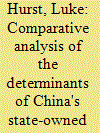

|
|
|
|
|
| Publication |
2011.
|
| Summary/Abstract |
Chinese outward direct investment (ODI) is expanding at an unprecedented rate. The present study augments the understanding of the determinants and drivers of Chinese ODI. It reviews the literature on Chinese ODI and analyzes investment by state-owned enterprises (SOE) for the period 2003-2008, focusing specifically on the differences between the determinants of Chinese investment in developed (OECD) and developing (non-OECD) economies. In addition, the study assesses the appropriateness of the general framework used for investigating ODI determinants (Dunning's eclectic paradigm) to analyze the experience of Chinese SOE. The findings indicate that Dunning's eclectic paradigm provides an excellent theoretical framework for analyzing the determinants of Chinese SOE investment in developed countries, and provides a good starting point for analysis of Chinese investment in developing countries. However, Dunning's specification requires refinement for developing countries. This paper finds a distinct difference between the motivations for Chinese SOE investment in developed and developing countries.
|
|
|
|
|
|
|
|
|
|
|
|
|
|
|
|
| 5 |
ID:
106013


|
|
|
|
|
| Publication |
2011.
|
| Summary/Abstract |
For some 20 years, the rate of investment by EU enterprises into China has been rising, reaching an annual average of some US$5bn over the 10 years to 2009. Conversely, the EU has not been a focus for Chinese investments, nor has Chinese investment been important to the EU despite the wide attention given to recent landmark cross-border acquisitions. Therefore, the overall impact of Chinese investment on the European economy is small. However, this situation might now be changing following institutional changes in the EU. In light of the potential for Chinese foreign direct investment to the EU, in this paper we outline the motives for, and patterns of, Chinese outward investments to the EU, and the impacts that these investments might exert on the recipient.
|
|
|
|
|
|
|
|
|
|
|
|
|
|
|
|
| 6 |
ID:
106011
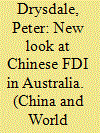

|
|
|
|
|
| Publication |
2011.
|
| Summary/Abstract |
Australia is China's largest destination for FDI, most of it directed to the resource sector. The scale and speed of the surge of Chinese investment into Australia, largely from state-owned enterprises (SOEs), has raised the question of whether investments by SOEs require special scrutiny. In China, the question is about the treatment of Chinese investment compared with investment from other countries. Clearly, Australia has had a policy environment that is very open to foreign investment, including investment from China. Nevertheless, it is questionable whether measures recently introduced in Australia to review investment by SOEs will restrict Chinese access to the Australian market or encourage a change in the nature of investment projects. How will Chinese enterprises need to adjust to the disciplines and rules in foreign markets? Will the Chinese Government need to take the regulations of host countries like Australia into account in its supervision of SOEs? Australia remains more open to Chinese investment than any other country in the world. Although the issue of SOE investment raises important new questions for policy-makers in Australia and other countries, Chinese investment in Australian resources is very beneficial and, with appropriate institutional and policy initiatives, will continue its strong growth.
|
|
|
|
|
|
|
|
|
|
|
|
|
|
|
|
| 7 |
ID:
106010
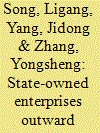

|
|
|
|
|
| Publication |
2011.
|
| Summary/Abstract |
Since China's accession to the WTO in 2001, China has been on a steep learning curve in terms of engaging in outward direct investment, and state-owned enterprises (SOEs) have played a predominant role in this drive. We argue that investment overseas by SOEs is a double-edged sword as far as its impact on domestic reform is concerned. Investing overseas offers opportunities to deepen structural reform in China, but such investment could also strengthen the monopoly position of some SOEs, which is inconsistent with the objective of domestic reform. Therefore, it is important for China to deepen domestic reform with respect to competition, ownership and regulations, to maximize the benefits from investing overseas. The present paper also discusses how building market-compatible institutions will result in increased innovation. This provides opportunities for Chinese firms to effectively catch up with the advanced technologies to remain competitive in overseas markets.
|
|
|
|
|
|
|
|
|
|
|
|
|
|
|
|
|
|
|
|
|